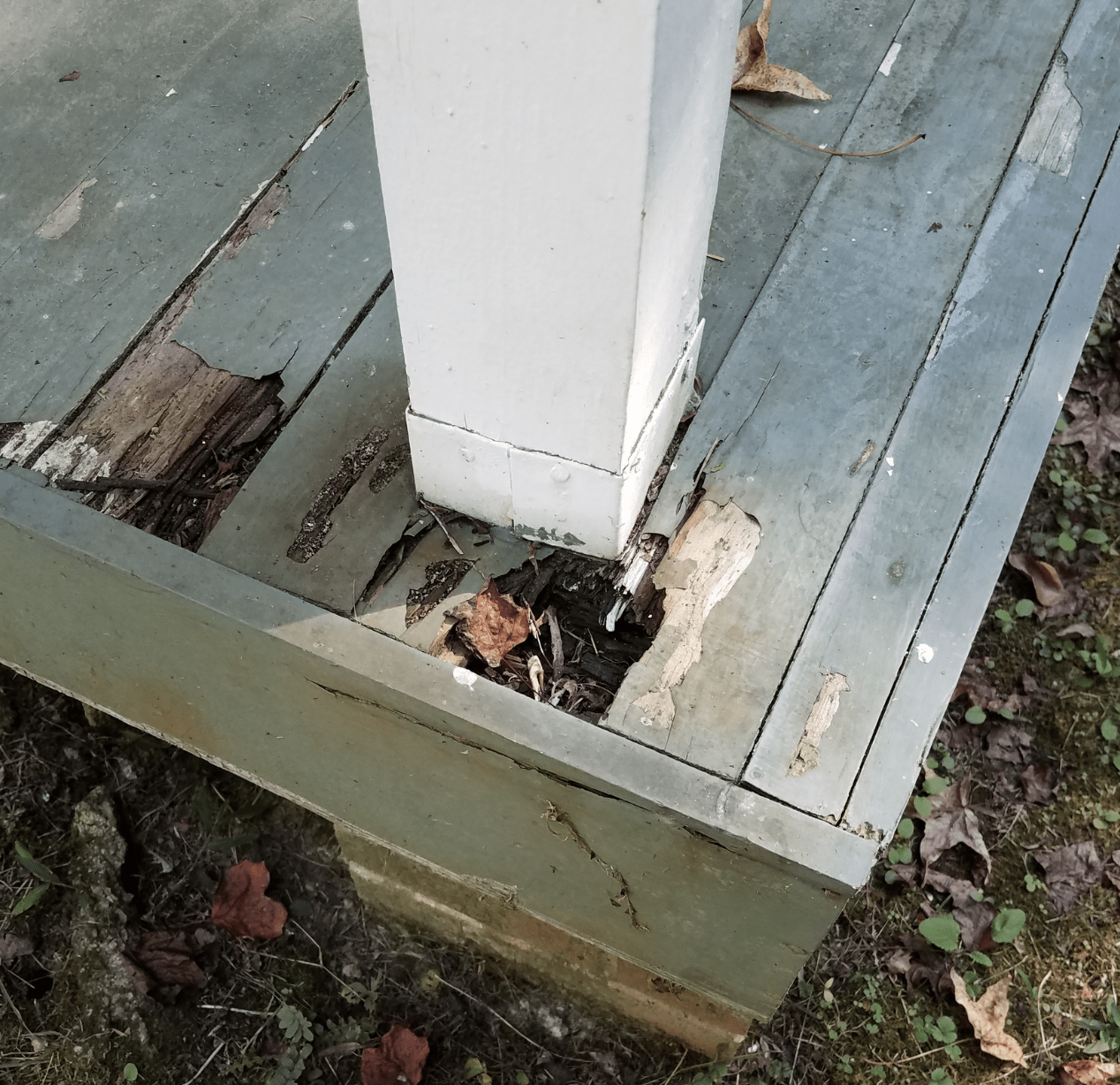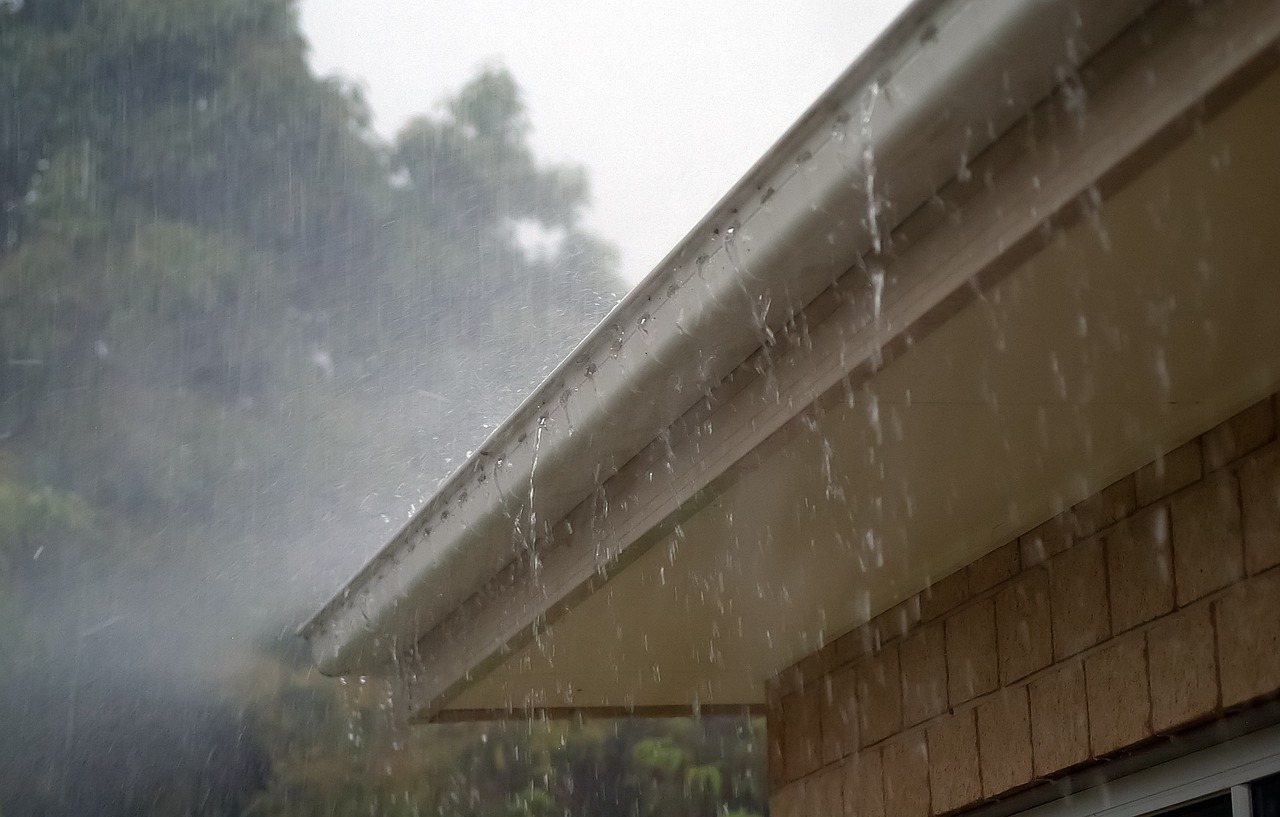Key Takeaway
Inspecting your wood porch columns for moisture damage twice a year and after big storms is the simplest way to protect your home. A few minutes of prevention now can save you from expensive repairs later.
Why Regular Inspections Matter
Moisture is without a doubt one of the biggest threats to wood. When water soaks into columns, it can cause swelling, soft spots, mold growth, or structural weakness. If this is left unchecked, damage can quickly spread and lead to costly repairs. Catching these issues early means you can sand, seal, or repaint small problem areas instead of paying for full replacements later.
Signs of Moisture Damage to Watch For
When inspecting your porch columns, look closely for:
If you notice any of these, it’s a red flag that water is getting in.

Rotted Wood Porch Column with Moisture Damage
Moisture damage often starts at the base of wood porch columns.
Best Times of Year to Inspect
You can check your columns anytime, but there are key seasons when inspection is especially important:
In addition, it doesn’t hurt to perform a quick check after major storms or if you notice water pooling near your porch. These extra looks don’t take long but can save you from big problems later.
How to Inspect Your Porch Columns Step by Step
You don’t need special tools to perform a basic inspection. Here’s a simple routine:
- 1Look closely at the surface. Check for peeling paint, cracks, or water stains.
- 2Press gently with your hand. Soft or spongy areas suggest rot beneath the surface.
- 3Examine the base. Moisture damage often begins where the column meets the porch floor.
- 4Check the top and joints. Water can sneak in through seams or loose trim.
This whole process takes less than 10 minutes from start to finish per column.
What to Do if You Find Damage
If you see minor moisture damage, you may be able to take care of the repair yourself. Start by both sanding and resealing small surface spots. Then replace any loose or missing caulk.
A fresh coat of paint can block out further water from entering. If the wood feels soft or crumbles easily, it’s best to call a professional. When columns are deeply rotted, replacement is usually the safest choice, since moisture damage can spread to the porch roof and surrounding structure.
At that point, investing in new custom wood columns built to handle years of outdoor exposure can restore both the strength and style of your porch.
Prevention Tips for Moisture Damage
Regular maintenance helps keep porch columns strong. Keep paint or stain in good condition to seal out water, and clear away leaves or debris at the base where moisture can collect.
Make sure gutters and down spouts send water away from the porch, not towards it. Every few years, you should see about reapplying caulk around joints and trim to close off gaps where moisture can sneak in. With these habits, your columns will last longer and require fewer costly fixes.

Overflowing Gutter During Rainfall
Poor drainage from gutters can cause moisture damage to porch columns.
Seasonal Porch Column Inspection Checklist
Use this quick list twice a year (spring and fall) to stay ahead of problems:
Keeping this checklist handy makes inspection a simple, repeatable habit that will stick.
Frequently Asked Questions (FAQs) for Wood Column Moisture Damage
- All
- Column Moisture Damage – Lifespan & Maintenance
- Column Moisture Damage – Prevention & Care
- Column Moisture Damage – Repair & Replacement
- Column Moisture Damage – Safety & Stability
Keep paint or stain in good condition, clear away debris at the base, direct water away with gutters, and reapply caulk at joints every few years.
Well-maintained wood porch columns can last decades. With regular inspections, sealing, and repainting, they can last many years before major work is needed.
Yes. Properly working gutters and down spouts keep water away from the porch base. Overflowing gutters can funnel water directly onto columns, which speeds up rot.
Most homeowners will choose to repaint or reseal every 5–7 years, but high-moisture climates may require shorter intervals. Regular inspection helps you decide when it’s time.
Cosmetic damage looks like peeling paint or surface stains, but the wood underneath is still firm. Structural rot makes the wood soft, spongy, or crumbly, which can weaken the entire column.
Yes. Columns carry part of the load of the porch roof. If they weaken, the roof may sag or allow water to leak into surrounding areas.
If the column shifts when you press against it, sags under weight, or shows deep rot at the base, it may no longer be structurally sound. Contact a contractor right away.
Custom wood columns designed for outdoor use, sealed and finished properly, give you both strength and style. These columns can be tailored to match your porch design while resisting moisture over time.
Replacement is the safer choice when columns have deep rot, feel unstable, or show decay at the base where they support weight. Trying to patch serious damage can leave your porch structurally weak.
Yes, but only if the damage is on the surface. Sanding, sealing, and repainting can stop it from spreading. If the wood feels soft or crumbles, a full replacement is usually needed.
